Search: Side Tackle And Into The Jackal
Tackling 10 - Side-on Tackle
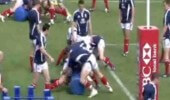 1:03
1:03
British Lions - tackle then Jackal then clear out
Many of these drills require repetition, here we see how the importance of good body shape in contact can be practiced as both the jackler and those clearing out the tackle
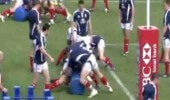
British Lions - tackle then jackal then clear out
This technique proved so successful they adjusted the rules to prevent its use, what was the rules change and can you coach it?
To watch over 2500+ videos join now for free!
JOIN NOW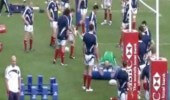 1:01
1:01
British Lions - tackle then jackal
It is important to practice not only the body shape of the defender but also those doing the clearing out of the defender
 5:13
5:13
How to coach the Catch or Choke Tackle
Some of the latest ideas around tackle technique and what defenders are trying to achieve. This session provides the technical progressions needed to teach the choke / catch tackle
 4:29
4:29
Kiwi Tackling - Coaching Dominant Tackling
To be a dominant tackler you need to practise the core skills regularly. The tackle has many factors to it and here are some tips from New Zealand
Tackling 11 - Rear Tackle
Tackling - Rear Tackle
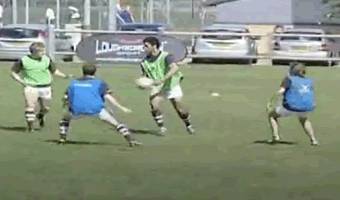 4:30
4:30
Small-side game - Ruck Touch
There are many versions of ruck touch with the support players needing to recognise the needs of the tackled player.
The defence should be conditioned to provide increasing pressure to the tackle area. This will develop the situation recognision of the attacking players who must play accordingly. Robotics in rucking regardles of the situation should be discouraged and the option of picking upthe ball and going forward should be an option
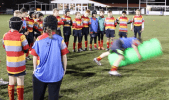 5:51
5:51
Tackling - When is the tackle completed?
It is very much an individual choice as to when a tackle is completed to when the defender can compete for the ball. What is generally accepted is that good tackle technique will enable the defender to "Be ready" for his next task. This clip explores why a strong grip or "Ring of steel" will enable the tackler to be dominant
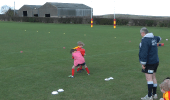 2:11
2:11
Tackle Technique - Head Position
With the attacker holding a tackle shield, and running either left or right of the defender, the key point of this drill is ensure the tackler's head is on the right side.
 5:28
5:28
Kiwi Tackling - Pre Tackle Practises
Sharing our coaching ideas is great for the game. Players in New Zealand hone their skills at an early age and it is globally accepted that they have the best techniques across all positions. Coaching the tackle is a key fundamental that all players practise regularly
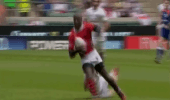 0:37
0:37
Sevens - Classic Tackle 1
Good tackle technique when chasing a player from behind. The defender gets to his feet quickly to contest the ball. Key factors : Head to one side - Arms around attackers waist and slide down - Keep your arms around the attackers legs - Use momentum to get back to your feet
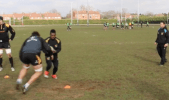 4:10
4:10
Wasps Tackle Safely & Dominate
Coaching a safe head position for tackling is not only a "Duty of care" for coaches but it also developes great body position and the platform to drive your opponents backwards. This video shows how physical the Wasps players are but not without safety & accurate technique
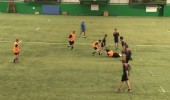 1:52
1:52
Tackle games - 5v5 Semi-contact
The sides are now even and the players can tackle, but not attempt to steal the ball. Again, the defence must retreat 5m, giving the attackers opportunities.
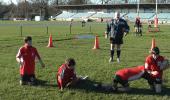 0:37
0:37
Tackling on Knees - 3 v 1
Using three attackers ensures the defender tackles on both sides and from slightly different angles. The coach can vary the pace and width of this exercise
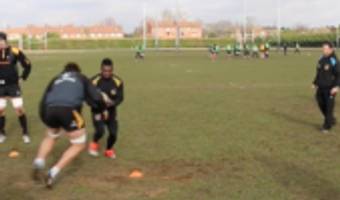 2:18
2:18
Tackling 20 - 2-man Tackle
Tackling 20 - 2 man Tackle
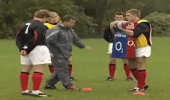 12:52
12:52
Tackle Technique - Progressions for Juniors
This clip illustrates tackle technique using progressions suitable to all players and possibly requiring regular revisit to embed safe and effective tackling
Tackling 9 - Revise Tracking and Front Tackling
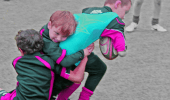 5:24
5:24
Develop Confidence For Tackling
Developing confidence in and around the tackle is very important when starting to teach tackle techniques. This clip provides a few ideas that you could use in your sessions
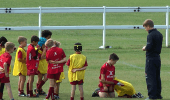 7:59
7:59
Learning to Tackle - Under 9's & Up
The RFU new rules of play have completely changed the approach of introducing young players to tackling. A phased approach may challenge previous methods however by viewing the practical session on this video you can see how the process works
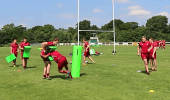 2:27
2:27
Reaction Tackle
Keep your players on their toes with this quick-fire 1v1 tackling exercise. Start with bags then progress to live tackles. Defending players have an obstacle to negotiate before performing the tackle, just as they may have in a game.
Offensive Front Tackle
The offensive front tackle
This practice shows front tackle technique when the defender is in a strong and balanced position
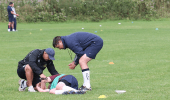 3:51
3:51
Player Welfare and Tackle Technique
Head injuries are a serious consequence to rugby and an area that deserves the attention of all players and coaches. Be proactive by coaching and re-coaching tackle technique to reinforce good habits.
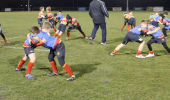 6:32
6:32
Tackling - Hook & Grip For Safety
The "Hook & Grip" element in the tackle creates strong & effective contact with your opponent which enables accurate tackling. A strong grip (Ring of Steel), is the precursor to a dominant tackle and this skill is crucial for all players. The practises in this video are excellent for players who may lack confidence or where you have a variety of competence among your squad
 5:15
5:15
Coaching tackle technique in groups
The ability to move from 1 to 1 tackling exercises into unit & group skills can be tricky. Here are some tips that you could use
Passive Front Tackle
The passive front tackle
This tackle is necessary when the defender is not in a position to make a strong aggressive tackle and uses the momentum of the attacker to bring them to the ground
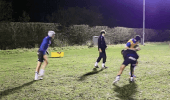 3:48
3:48
Junior Tackle and Breakdown
Good tackle technique leads into being effective at the breakdown, this clip provides advice on how to coach the tackle combined with the next phase of getting to your feet and competing for the space or ball
Tackling 4 - Feet and Body Position
Tackling 4 - Feet and Body Position
 5:07
5:07
Tackle Technique - Full Session
[WITH DRILL VIDEOS] This session from Joe Goodman (Bristol University Rugby) has been designed to prepare players for a return to full contact competition, re-establishing correct technique to ensure safe, efficient tackling through progressively increasing the level of contact and complexity of skill execution.
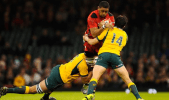 3:44
3:44
Tackling Aussie Style
Australian coaches across all age groups have a slightly different approach to teaching the tackle, or do they? You can take a few of their tips and integrate them into your coaching process
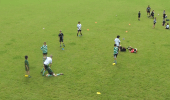 1:45
1:45
Tackle Technique in groups
Give players the opportunity to practice their tackling technique. In groups of five, one player in the middle has four tackle attempts. Make sure everyone has a go and the key points are repeated.
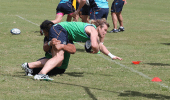 3:21
3:21
NSW Waratahs Tackle Technique
Some insight into how the NSW coaches approach coaching the tackle. This clip provides some tips on "How to coach" and some practical examples
Tackle technique
Learning Tackle Technique
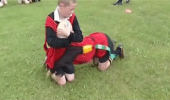 5:54
5:54
Defence - Tackle Progressions
Understanding tackle techniques and the progressions is integral for all coaches as a basic fundamental in coaching contact. The IRB "rugby ready" course provides a step by step approach to compliment the technques in this section
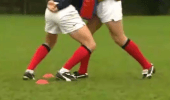 1:28
1:28
Tackle Technique 1/5 - Foot Position
The first step in this session on improving tackle technique, is focused on foot position and getting a strong base close to the target.
Tackle technique 5
Tackle technique 5
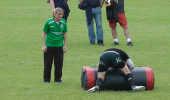 1:32
1:32
Turnover session - Learn to Jackal
This drill encourages players to contest for the ball while staying on their feet.
Progress to include reaction to a tackle and focus on getting on your feet quickly
Tackle technique 1
 3:56
3:56
Tackling games for juniors
Tackling and contact are key components in the development of young players, this clip shows how coaches can introduce tackling using a game that reduces the risk of injury and focuses on the technical skills
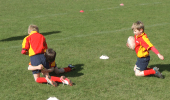 1:51
1:51
Tackle on Knees
An easy progression into tackling, with some movement. Use to build players' confidence before moving into full tackling.
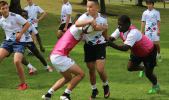 5:59
5:59
Quins- Tackling Warm Up Game
A fun game to get players ready both mentally and physically for contact and tackling. Applies to most age groups
Impact Guard Tackle
This tackle is used when close to either try line and intended to stop the ball carrier from moving forward
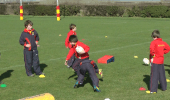 2:24
2:24
1 v 1 Tackling in Channel
An opportunity for players to put what they have learnt on tackle technique into practice. Each tackle is observed by all other players who can give feedback. Ensure all players have a go at attacking and defending.
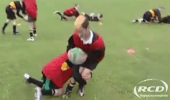 1:20
1:20
Introduction to tackling - Step 2
The transition from practicing tackling on knees to tackling on feet starts with the tackler remaining on their knees and the ball-carrier walking past. Then progress to having both players on their feet, but still executing the tackle at a controlled, walking pace.
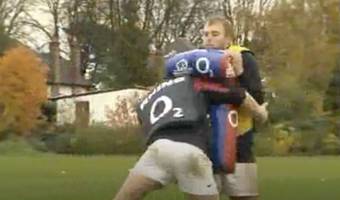 4:23
4:23
Impact Wrap Tackle
Impact Wrap Tackle
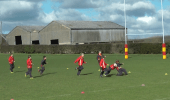 2:28
2:28
Tackling Game
A full-contact game with uncontested breakdowns, conditioned to have one team attacking for an extended time. The focus is on the defenders, who each have two tennis balls, to concentrate on their tackle technique.
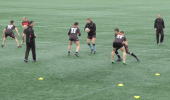 5:57
5:57
Games & drills for tackle technique
The Falcons coaches use a variety of games and breakout drills to progress their tackle technique session. The players respond to questions to vary the style of coaching
Tackling 25 - Conditioned Games
 6:05
6:05
Tackle Technique & Progressions
Introducing tackle technique to players is a challenging process and the Wasps coaches ensure the players understand and are competent at each step prior to progressing to the next one
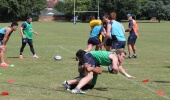 1:57
1:57
Tackle Technique Tips
Defence is a crucial part of the game, and it all starts with a solid tackle technique. Here's an introduction into a typical defence session, with some basic progressions focusing on body position and linespeed. Log in to see the full session.
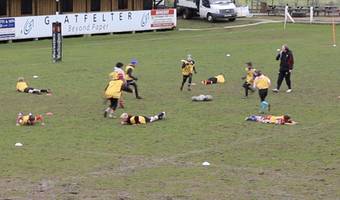 3:11
3:11
Fun Tackling Games
Try these fun games for any junior team. They are a great way to introduce tackle safety whilst keeping your players entertained.
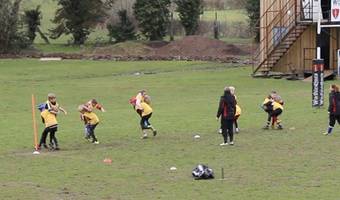 3:54
3:54
Intro To Safe Tackling
In this video we take a look at how these coaches introduce young players to safe tackle technique.
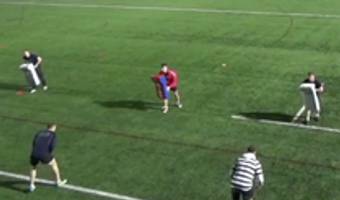 1:02
1:02
Chop Tackle - Pad Drill
Aim to develop good tackle habits through repetitive practice. Using pads allows you to train with intensity whilst lowering the impact on the body.
Tackle technique
Learning the tackle technique
Tackling 3 - Hunting a Tackle
Tackling - Hunting a tackle
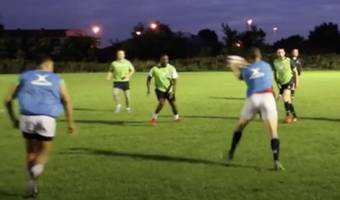 3:39
3:39
Two Touch With Tackle Practice
This game has multiple conditions for both attackers and defenders. Dropping defenders to practise their tackling while working on support lines and groundwork for the attackers. Great for the first half an hour of your session
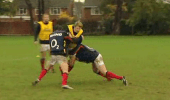 1:32
1:32
Double-tackle Technique
Double-tackles are useful against a team who like to offload. Leg drive can put them on the back-foot.
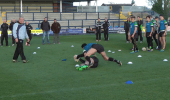 3:48
3:48
The Tackle Battle
Winning the collisions in contact is crucial in the modern game. The coaches provide some theory and practical examples of drills and games to reinforce the basic principles to be effective. The coaches use a variety of progressions and games to keep the session challenging
 1:52
1:52
Explode Up Tackling
Tackler starts on their knees. As the ball carrier gets closer the tackler steps up to give them more power and punches through to give them more power. The tackler drives through and finishes on top.
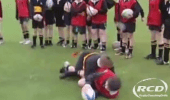 1:00
1:00
Introduction to tackling - Step 3
Repetitive exercises can help players become familiar with tackling technique.
Tackling 24 - Game Situations and Kick Chase
Tackling 1 - Tracking
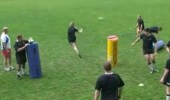 0:26
0:26
Tackle bag drill 3 man support after tackle
This is a very effective drill for developing decision making and awareness in support runners off a tackle situation
Tackling 22 - The Out to In Defence
Coaching 7-a-side Rugby - Side line press
In Defence:
Stay alert, keep on toes, specific communication, react, work hard
Defend what is happening – not what you think is going to happen
Trust the defence system, trust your team mates – trust yourself
 4:03
4:03
Wasps - Footwork The Key To Big Tackles
Aggressive tackling is fundamental to Wasps performances and their players physicality is part of their DNA. Brad Davis overseas a tackle technique session that will change your approach to coaching the tackle
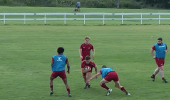 4:34
4:34
Game - Tackle Touch
Whether you're introducing tackling to young players for the first time, or re-introducing it to senior players after a summer away, this is a great game to play to ease back into it. It isolates the 1v1 tackle and puts emphasis on technique without the high speed impact of a full contact game.
 1:45
1:45
Around The Clock Tackling
Set up 5 cones around in a circle. The tackler works out from the first cone to make the tackle. The tackler then backtracks around the next and then comes forward to make the tackle again. Two tackles off the right shoulder, one front on and two off the left shoulder.
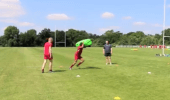 4:17
4:17
Technical Fitness with Tackle Bags
Tackle bags are a great tool to use in your conditioning sessions. The reduced impact allows players to peform high repititions of contact technique under fatigue, with low risk of injury.
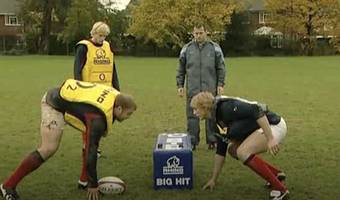 1:45
1:45
Passive Guard Tackle
This tackle is necessary when the defender is not in a position to make a strong aggressive tackle and uses the momentum of the attacker to bring them to the ground
 1:59
1:59
Chopping Feet To Coach Safer Tackling
Use equipment or players to force players to take smaller steps prior to the tackle, as attackers get better at late movement defenders need to practise in more demanding positions
 1:24
1:24
Tackle Technique Summary
Basic tackle technique is essential to rugby players of all ages and standards.
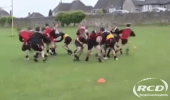 0:50
0:50
Introduction to tackling - Step 4
Jailbreak is a fun game that allows young players to become familiar with live tackling, as well as evasion. The game is played in a small area, to the increase the chance of tackles being made, and reduce the speed of the ball-carriers.
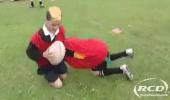 1:45
1:45
Introduction to tackling - Step 1
To build confidence in tackling technique and taking contact, it can be a good idea to start with players on their knees.
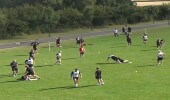 0:46
0:46
Tackle Technique Warm-up
Tackle Technique Warm-up
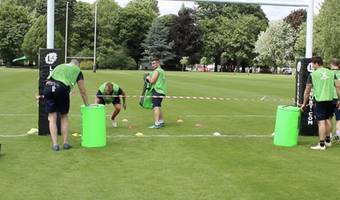 1:20
1:20
Developing Low Tackle Technique
Here is a new drill from London Scottish that encourages players to stay low in the approach and throughout the tackle
 3:33
3:33
Quins - Choke Tackle Technique
Harlequins coaches and players discuss the choke tackle, as well as the importance of enjoyment at training, and differences between players
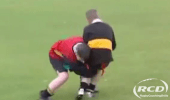 1:30
1:30
Learning to tackle - Step 5
Putting more pressure on players to take responsibility and make a tackle, 1v1 drills are challenging for young players, but also very beneficial.
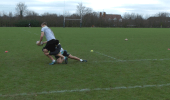 0:57
0:57
Coaching the leg Tackle
An example of a basic 1v1 exercise to practice the leg tackle.
Tackling 19 - Conditioned Games
Tackling 19 - Conditioned Games
 3:48
3:48
Tackle - Coaching safe head position
Coaching the correct head position for tackling is one of the most important skills for a coach, this clip shows a few examples that can be used with progressions
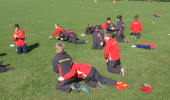 0:51
0:51
Tackle Technique - Introduction
The introduction of tackling is regarding by many coaches as the biggest challenge for volunteer coaches. This clips provides a summary of the main points
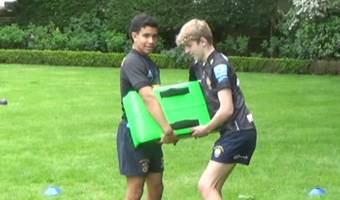 0:46
0:46
Tackle bag Grapple
In pairs. Each player grabs one end of the tackle pad. The players wrestle to grab the tackle pad from the other players grasp. Repeat a couple of times.
 6:44
6:44
Coaching tackle technique & progressions - Mini
Coaching tackle technique never stops. As players get older, the challenges become more complex and coaches need to provide more detail to improve the finer skill sets. This video provides some expert tips that may help you improve tackle technique and the first phase of the ruck / breakdown.
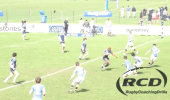
Missed Tackles
Missed tackles can be hugely damaging, particularly in sevens. Here, Filton College benefit from a missed tackle, to run in an easy try.
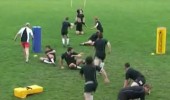 0:11
0:11
Offload out of the tackle in channel
A good start for developing offload and tackle skills, allowing you to manage the amount of contact in the tackle whilst performing the skill successfully. Key factors : Strong base - Lead with arm and shoulder - Keep looking forward with head up - Wrap arm around legs / waist and squeeze tight with other arm - Use attackers bodyweight to rotate your body
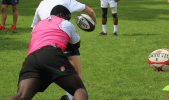 2:54
2:54
Quins - Tackle Technique 1 v 1
A new tackle technique exercise without the "Bone on Bone" collisions
 3:40
3:40
Tackle Techniques For Hard Ground
Tackle practise during the summer months can be tricky with the hard grounds. Using contact shields to improve the key safety features should be part of your training toolbox
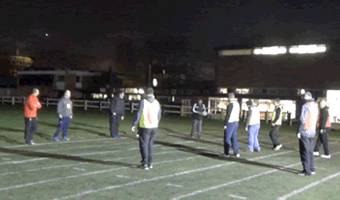 2:12
2:12
Speed To Breakdown Game
Within the defensive side, mark some players as tacklers only and some a jackalers only. It is up to the attack to identify holes and the defence to ensure they are quick to the breakdown.
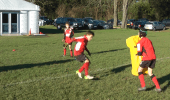 1:04
1:04
Tackle Technique in channel
Use a channel with attackers and defenders to progress the tackle technique, mix the players up so they all have opportunities. Reinforce the coaching points and give praise regularly
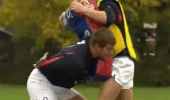 1:00
1:00
Tackle Technique 2/5 - Body Height
This step concentrates on achieving a lower body position before making a tackle.
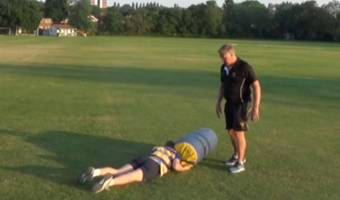 1:05
1:05
Sausage Pad Tackling - Getting Low
Make sure players are getting low early and close to tackle the sausage pad, they shouldn't be diving into the pad.
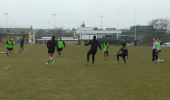 2:59
2:59
Quins Defence - Tackling in units 3 v 3
This exercise is part of a tackle technique progression and pitches 3 attackers v 3 defenders. As in match play the attacking players will present different challenges to the defenders. The coaches can choose to alter the conditions to put more or less pressure on the players
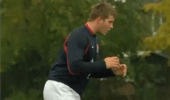 1:21
1:21
Tackle Technique - Boxer's Hands
Players should have their hands up ready, so they can wrap around when making a tackle.
 1:36
1:36
The Choke Tackle
The choke tackle is a technique used to slow attacking ball down. By wrapping the attacker high around the ball and lifting them slightly, their momentum is reduced and they are unable to make the offload. The longer a tackler can keep them from going to ground, the more time the rest of the defence have to get ready.
 0:29
0:29
Women's - Classic Tackle
Women's - Classic Tackle
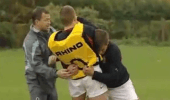 0:50
0:50
Tackle Technique - Tight Grip
As the tackler wraps his arms, they should try to grip on to execute a more secure tackle.
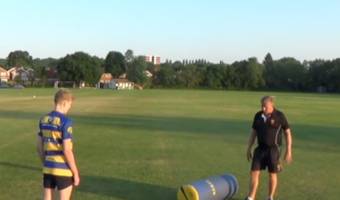 1:05
1:05
Sausage Pad Tackling - Getting Low
Make sure players are getting low early and close to tackle the sausage pad, they shouldn't be diving into the pad.
 0:54
0:54
Women's - Wrap Tackle
Women's - Wrap Tackle
 1:44
1:44
London Irish - Tackling With Matts
An interesting approach to improving your tackling, using crash matts? Declan Danaher the defence coach at Irish uses a variety of equipment but says "Using matts has revolutionised our defence"

